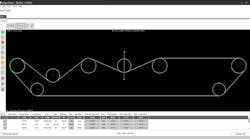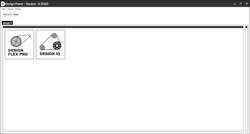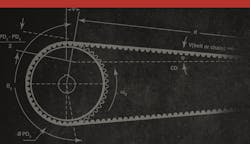Design software comes in many varieties and can greatly benefit development teams. Advancements over the years have helped to improve the productivity of design teams by reducing the amount of time spent developing a product as well as the amount of physical work needed to do so.
New design tools are continually entering the market to help improve the efficiency and accuracy of designs.
Manufacturer of power transmission and fluid power solutions Gates has launched Design Power. This new software platform includes several digital design tools to aid with engineering and specification of belt-drive systems.
Cadence Design Systems Inc. has also recently introduced a new software tool, Cadence Fidelity CFD. It is a suite of computational fluid dynamics (CFD) solutions designed to increase turnaround time while ensuring accuracy.
Gates Design Power
According to Gates, the new Design Power platform features some of the most sophisticated belt-performance models available in the industry. These were developed based on data Gates has gathered over the years from its test laboratories. The company says this helps to ensure customers are able to design robust, application-specific drive systems when utilizing the software.
The Gates Design Power software platform contains six modules, four of which are new applications. Upgraded versions of Gates' Design IQ and Design Flex Pro digital tools are included, as well.A Mobility Drive Analysis tool—which Gates says is an industry first—is one of the new programs available in the platform. It is designed to help OEMs in various applications such as motorcycle and power sports more easily integrate clean, quiet, durable and low-maintenance Carbon Drive belt systems from Gates into their products.
Gates says there are features included in the software platform which are aimed at improving the design process as well as making it easy to use and design belt drives for engineers of all skill levels, including inexperienced ones. A collaboration functionality allows users to work with a Gates application engineering experts to optimize their designs.
Industry knowledge built into Gates Design Power offers design guidance for those with more advanced engineering skills.
The platform also automatically synchronizes with Gates' product catalog to make it easier for users to find and learn about the products they want to use in their designs. Multiple designs can be stored in a single project file, the company says, allowing design teams to easily track design derivations and iterations while also enabling them to make notes as changes are made.
Gates Design Power is available globally as a fee download with 15 languages included. The company plans to continually develop the platform to provide more features and enhancements to further benefit users.
"At Gates we are committed to relentless innovation and finding ways to make our customers’ lives easier. Digital innovation is as important as product innovation in making this happen," said Tom Pitstick, chief marketing officer and senior vice president of strategic planning for Gates, in the company's press release announcing the launch of Design Power. "The new Gates Design Power software platform builds upon our existing design tools to support our Global ‘Chain to Belt’ initiative, making it even easier for engineers across all applications, from two-wheelers to manufacturing equipment, to design-in our products and get the most out of their belt drives."
Cadence Fidelity CFD Software
Cadence's new CFD software aims to improve the performance and accuracy of multiphysics simulation for various applications including automotive, turbomachinery, marine and aerospace. The company says its Fidelity CFD software offers a next-generation flow solver with high-order numerics, scale-resolving simulations and massive hardware acceleration. All of these work together to help increase performance and speed up turnaround time of CFD simulations while maintaining accuracy.
Fidelity CFD brings together various technologies an engineer would need to simulate the performance of multiphysics system in a streamlined workflow states Cadence in its press release announcing the launch of the software tool.
The software features several specialized flow solvers for marine and turbomachinery applications along with general-purpose ones for an array of flow types. Fidelity CFD can help engineers to evaluate and address noise around a vehicle, optimize the power generated by wind turbines as well as reduce fuel consumption of engine-driven vehicles or equipment. All of this can be done in a fast and accurate manner, helping to reduce development time for design teams.
Next-generation, high-order flow solvers with advanced simulations of fluid turbulence are included in the software which can predict aerodynamic drag on a road vehicle up to 10 times more accurately than a traditional CFD solver the company says. And turnaround time to run this type of simulation is reduced to a day or less compared to weeks.According to Cadence, a unique feature of the software is the combined meshing expertise from the NUMECA and Pointwise companies which it acquired in 2021. Geometry and meshing can take up to 75% of an engineer's time but integration of these companies' capabilities into the software, which is ongoing, helps to reduce the amount of time needed for this work.
"We chose NUMECA Autoseal and Hexpress to be our standard workflow for CFD preprocessing," said Antoine Delacroix, Manager Vehicle Performance Engineering R&D at Toyota Motor Europe, in Cadence's press release. "They allowed us to reduce our total lead time and work hours respectively by 91% and 97% while consistently providing high-quality meshes with excellent layer coverage.
"Since becoming part of Cadence, the team has continued to deliver valuable new solutions. We like the integration of all these tools in Fidelity CFD and look forward to continued innovations."





